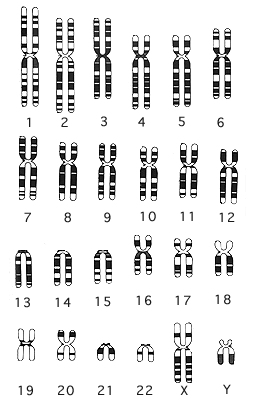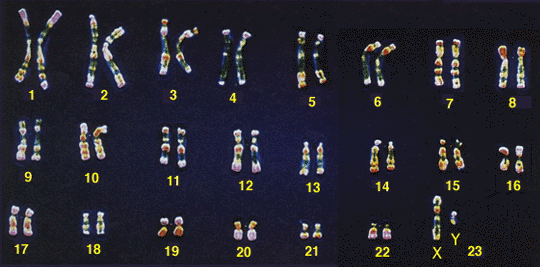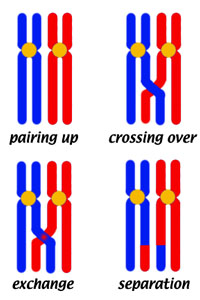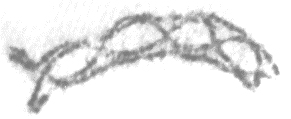BIOL 1400 -- Lecture Outline 15
"Doubt is not a pleasant condition, but certainty is ridiculous." -- Voltaire
I. Meiosis -- a second type of cell division. . .
- Chromosome numbers
- The chromosomes in a eukaryotic cell are of different sizes and shapes,
which can be sorted by size and by banding pattern (chromosomes stained
with particular stains show patterns of light and dark bands).
- What I didn't tell you in the last lecture is that, usually, chromosomes come
in pairs within a cell.
- This is true for most animals -- in most of their cells, there are two copies
of each chromosome. (Algae, fungi, etc. do things a bit differently -- more later,
if I can manage it.)
- Having two of each chromosome is known as being diploid.
- There are some instances of cells having three, four, five, six, etc. of each
chromosome -- they're said to be triplod, tetraploid, pentaploid, hexaploid, etc.
We need not go into this -- it's very rare in most vertebrates for a cell to have
more than two of each chromosome.
- Egg cells and sperm cells, however, have only one copy of each chromosome.
They are said to be haploid.
- When a haploid egg and a haploid sperm meet and fuse, they form a diploid
cell, called a zygote.
- The zygote, and the organism that it grows into, have one member of each
chromosome pair from the mother, and one member from the father.
- Most human cells have 23 chromosome pairs = 46 chromosomes.
We number them off by size: geneticists talk about "Chromosome 1", "Chromosome 2",
and so on.
- Different organisms have different chromosome numbers: fruit flies have four
pairs, horses have thirty-two, etc. etc.
- The number of chromosome pairs is referred to as N. Thus for humans,
N = 23. Diploid cells are said to be 2N.
- There's one exception to the rule that chromosomes come in pairs. . .
- In the cells of female mammals, there are normally a pair of large chromosomes
that we refer to as the X chromosomes.
- Male mammals, however, normally have only one X chromosome, along with a very
small chromosome called the Y chromosome.
- We say that females are XX and males are XY. These are the
sex chromosomes.
- The Y chromosome contains a "switch" that causes a developing embryo to
become male -- if it's not there, the embryo develops "by default" as a female.
(Maybe I can talk later about what that "switch" is and how it works. . .)
- This doesn't apply to all animals! Most have different ways of determining sex.
But it applies to humans.

Diagram of the banding pattern of each chromosome. For simplicity, only one
of each pair is shown. Note how each is composed of two
chromatids attached at the centromere.

Human chromosomes stained with a special fluorescent stain. Notice
that there are twenty-three pairs. (Note the difference between the X and the Y
chromosome. . . .)
III. Meiosis -- actually a two-stage division
- Meiosis I:
- Meiosis starts with a diploid cell in interphase.
- Again, the chromosomes double when the DNA replicates.
- In prophase I, doubled chromosomes condense again. . . BUT, UNLIKE
mitotic prophase, the members of each chromosome pair attach to each other.
These paired chromosomes actually exchange pieces of themselves with each other --
called crossing over.

Diagram of crossing over

Actual microscope view of two chromosomes crossing over -- note that
crossing over can (and usually does) happen at several points, not just one
- In anaphase I, the paired chromosomes separate from each other, but
the chromosomes don't break apart at the centromere.
- After telophase I -- the end of meiosis I -- each daughter cell
is haploid, but each chromosome is still composed of two chromatids.

Cells in the stages of meiosis I (these happen to be from the anther
of a lily flower)
- Meiosis II is essentially the same as mitosis.
- The two cells produced by meiosis I divide again. . . going through
prophase II and metaphase II. (Obviously, because the cell
is haploid, chromosomes don't pair up the way they do in meiosis I.)
- . . . and this time, in anaphase II, the double chromosomes break apart
into chromosomes of one chromatid each, just like mitosis.
- Net result after telophase II: One diploid cell -> four haploid cells.

Cells in the stages of meiosis II (again, from the anther
of a lily flower)
Images plagiarized shamelessly from
the
University of Wisconsin botany site -- surf over there to see larger images
and further explanations of meiosis.
- In animals, meiosis is the process by which eggs or sperm are made --
collectively, eggs and sperm are called gametes.
III. What can happen when it doesn't work. . .
- If a chromosome pair fails to separate at anaphase I, or a chromosome fails to
divide at anaphase II, the result is a cell with an extra copy or a missing copy of
one of the chromosomes.
- If a gamete with an extra copy of one chromosome unites with a normal
gamete, the resulting zygote has three copies of one chromosome and two copies
of all the rest.
- This is called trisomy.
- In humans, most trisomies result in miscarriage, or sometimes babies with
severe birth defects that rarely live longer than a few months.
- An exception is trisomy-21 -- having three copies of chromosome
21, one of the smallest. This is otherwise known as Down's syndrome.
- Trisomies are also possible for the sex chromosomes. Combinations such
as XYY (normal male with slight tendency towards aggressive behavior);
XXY (sterile male, tendency towards tallness and mental retardation;
"Klinefelter's syndrome") and XXX (normal female) are all known.
- If a gamete missing a chromosome unites with a normal gamete, the zygote
has only one copy of one chromosome. This is monosomy.
- In humans, almost always, a zygote with monosomy will spontaneously miscarry.
- The only exception is if there's only one copy of the X chromosome -- referred
to as X0 ("X-naught", "Turner's syndrome"). People with this syndrome are
female; they're sterile and tend to be short, but otherwise can lead normal lives.
Go to Previous Notes |
Return to Lecture Schedule |
Return to Syllabus |
Contact the Prof |
Go to Next Notes





